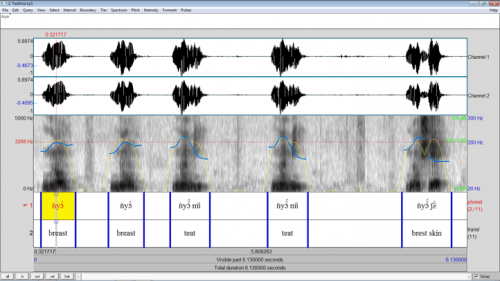Word order
The already collected Kyanga data show the exceptional status of the language within Mande. Linguistic analysis of the already collected data has likewise shown that Kyanga/Shanga have retained linguistic features such as true SOV word order and aspect marking by verbal suffixes, which are relevant to the issue of Proto-Mande and Proto-Niger-Congo but otherwise lost in all or most other Mande languages. The perfective is marked by the perfective-stem that is characterized by low tone (1). The (imperfective) prospective is solely marked by the imperfective suffix –à on the verbal root (2):

Compounds
As in Mande languages in general, the modifier (determinans) follows the head (determinatum) in Kyanga. Compounds and associative constructions are not distinguished by morphological markers but by prosodic distinctions. Lexical compounds are marked by an extra-high tone, whereas associative constructions are not marked.


Fig. 1: F0-measurements of extra-high tone, contrast of compounds and associative constructions in Kyanga
Pronouns
Kyanga knows three sets of pronouns, one set of emphatic pronouns marking contrastive focus or information focus, and two sets which are tonally distinct depending on the syntactic position.

Tab.1: Kyanga pronoun-series
Tense, aspect, mode and polarity

Tab. 2: Verbal negation of all aspectual categories
Kyanga shows a basic grammatical aspectual dichotomy of imperfective/perfective that becomes very evident in negation, as imperfective and perfective use two different negation markers in the NEG1-Slot; bá for all imperfectives and ʧí for the perfective. Clause final both show the same marker bá. Mode is encoded by the predicate marker (PM) nà that precedes all aspectual markers as well as the negation marker. Tense is not expressed grammatically. Three aspects fall under the root category imperfective, that is the (unmarked) imperfective, the progressive and the prospective. All three aspects use of the imperfective stem of the verb word but differ in respect to the predicate markers that appear in the AUX-Slot in PM2-position. The (unmarked) imperfective is encoded by the clitic =í (6) the progressive by bí (7). The prospective does not use a predicate marker (8).

The habitual (9) differs in Kyanga from the imperfective aspects in respect to the form of the verbal word that appears in its unmarked form and according to the predicate marker tà. It is only the habitual that can further be modified by gũ̀/gʷã̀ to express the durative. In case the durative predicate marker occurs, the verb word shows the imperfective stem. However, the habitual’s negation equals the one of the imperfective aspects.

The perfective consists of one category only, the perfective. It is encoded by the perfective stem of the verb word only. It occurs, such as the prospective, without any predicate marker (10).

1 N = articulatory underspecified nasal consonant





